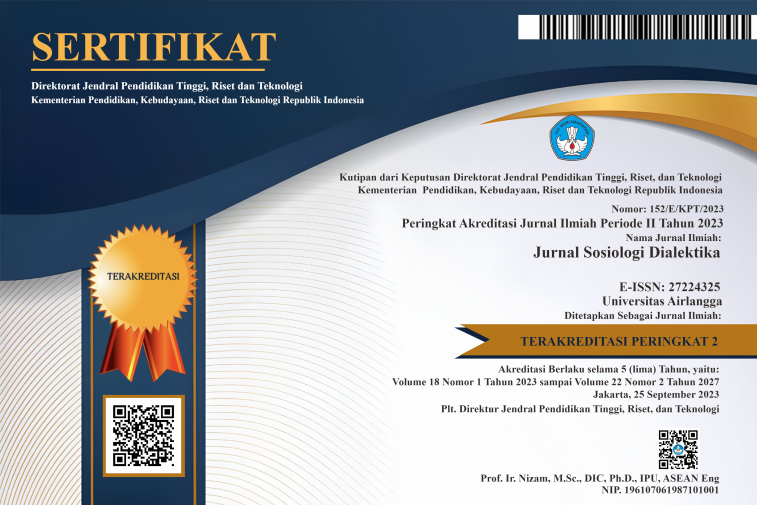Swearing and gender dynamics in urban Surabaya: Understanding Gen Z’s swearing in Surabaya’s arek culture
Downloads
Swearing in society is a multifaceted phenomenon influenced. The purpose of this research is to understand the context of swearing among Generation Z in Surabaya and the differences in swearing between male and female Gen Z individuals in Surabaya. This research uses qualitative research methods involving 45 Generation Z informants from Surabaya. The results of the research show that the decision by Gen Z Surabaya is influenced by emotional context, social norms, culture, and group bonding to strengthen social ties, express emotions, and maintain their unique identity. Male Gen Z in Surabaya use the swear word “jancuk” with a higher pitch and rarely modify it, while female Gen Z use it with a lower pitch and frequently modify it. The conclusions of this research are first, the context of swearing among Generation Z in Surabaya occurs in informal situations among close friends for joking, easing the atmosphere, and insulting to demean the conversation partner, all influenced by Arek culture. Secondly, the difference in swearing between male and female Gen Z in Surabaya is that male Gen Z often use a higher pitch and rarely use modified swear words, while female Gen Z do not always use a high pitch and often use modified swear words to maintain their image. The use of swearing by both male and female Gen Z within the Arek Surabaya culture demonstrates intimacy, openness, egalitarianism, and the absence of social distance.
Akhter K (2023) Gender differences in the use of foul language in Punjabi. European Scientific Journal ESJ 1. https://doi.org/10.19044/esipreprint.1.2023.p110.
Amelia ZS, Setia E, & Mono U (2022) Realization of swear word in Reynhard Sinaga’s case on ‘Twitter’. East Asian Journal of Multidisciplinary Research 1 (5):843-852. https://doi.org/10.55927/eajmr.v1i5.573.
Afrilya T, Suastini NW, & Jendra IM (2021) An analysis types and function of swear words used in PewDiePie’s video. ELYSIAN JOURNAL: English Literature, Linguistics and Translation Studies 1 (1):61-70. https://doi.org/10.36733/elysian.v1i1.1589.
Chun JW, Choi J, Cho H, Lee SK, & Kim DJ (2015) Dysfunction of the frontolimbic region during swear word processing in young adolescents with internet gaming disorder. Translational Psychiatry 5 (8):e624-e624. https://doi.org/10.1038/tp.2015.106.
Coats S (2021) ‘Bad language’ in the Nordics: Profanity and gender in a social media corpus. Acta Linguistica Hafniensia 53 (1):22-57. https://doi.org/10.1080/03740463.2021.1871218.
Creswell JW & Poth CN (2016) Qualitative inquiry and research design: Choosing among five approaches. Thousand Oaks: Sage publications.
Daly N, Holmes J, Newton J, & Stubbe M (2004) Expletives as solidarity signals in FTAs on the factory floor. Journal of Pragmatics 36 (5):945-964. https://doi.org/10.1016/j.pragma.2003.12.004.
Darics E (ed) (2015) Digital business discourse. Basingstoke: Palgrave Macmillan. https://doi.org/10.1057/9781137405579.
Denzin KN & Lincoln SY (2005) Qualitative Research (3rd ed. Vol. 3). Thousand Oaks: Sage Publications. http://doi.org/10.1017/CBO9781107415324.004.
DeFrank M & Kahlbaugh PE (2018) Language choice matters: When profanity affects how people are judged. Journal of Language and Social Psychology 38 (1):126-141. https://doi.org/10.1177/0261927x18758143.
Griffiths MA (2018) Brand vulgarity. Journal of Product & Brand Management 27 (4):404-414. https://doi.org/10.1108/jpbm-01-2017-1385.
Guba EG & Lincoln YS (2005) Paradigmatic controversies, contradictions, and emerging confluences.
Halliday MAK & Hasan R (1992) Bahasa, Konteks, dan Teks: Aspek-Aspek Bahasa dalam Pandangan Semiotik Sosial. Terjemahan Asrudin Barori Tou. Yogyakarta: Gadjah Mada University Press.
Hanggraito AA (2021) Jancuk: Public perceptions on the use of swear words in communication among arek cultural community in East Java. Jurnal Media dan Komunikasi 2 (1):1-14. https://doi.org/10.20473/medkom.v2i1.29355.
Herring SC (2003) Gender and power in on‐line communication. In: Holmes, J & Meyerhoff M (ed). The Handbook of Language and Gender. 202-228. https://doi.org/10.1002/9780470756942.ch9.
Hua Z (2020) Countering COVID-19-related anti-Chinese racism with translanguaged swearing on social media. Multilingua 39 (5):607-616. https://doi.org/10.1515/multi-2020-0093.
Husain W, Wasif S, & Fatima I (2023) Profanity as a self-defense mechanism and an outlet for emotional catharsis in stress, anxiety, and depression. Depression Research and Treatment, 2023: 1-10. https://doi.org/10.1155/2023/8821517.
Jay KL & Jay T (2015) Taboo word fluency and knowledge of slurs and general pejoratives: Deconstructing the poverty-of-vocabulary myth. Language Sciences 52: 251-259. https://doi.org/10.1016/j.langsci.2014.12.003.
Jay T (2009) The utility and ubiquity of taboo words. Perspectives on Psychological Science 4 (2):153-161. https://doi.org/10.1111/j.1745-6924.2009.01115.x.
Kapoor H (2014) Swears in context: The difference between casual and abusive swearing. Journal of Psycholinguistic Research 45 (2):259-274. https://doi.org/10.1007/s10936-014-9345-z.
Khalil U & Saleem H (2021) The impact of language attitude on the use of swear words: A sociolinguistic study of Pashtu non-native speakers of English. Sir Syed Journal of Education & Social Research (SJESR) 4 (2):251-257. https://doi.org/10.36902/sjesr-vol4-iss2-2021(251-257).
Kwon KH & Gruzd A (2017a) Is aggression contagious online? A case of swearing on Donald Trump’s campaign videos on YouTube. Proceedings of the 50th Hawaii International Conference on System Sciences. https://doi.org/10.24251/hicss.2017.262.
Kwon KH & Gruzd A (2017b) Is offensive commenting contagious online? Examining public vs interpersonal swearing in response to Donald Trump’s YouTube campaign videos. Internet Research 27 (4):991-1010. https://doi.org/10.1108/intr-02-2017-0072.
Lesmana D, Sudikno A, Wulandari LD, & Santosa HP (2021) Senses of place in Lawas Maspati village community at Surabaya: Exploration study towards physical, social, and cultural factors. ARTEKS: Jurnal Teknik Arsitektur 6 (1):67-74. https://doi.org/10.30822/arteks.v6i1.595.
Love R (2021) Swearing in informal spoken English: 1990s–2010s. Text & Talk 41 (5-6):739-762. https://doi.org/10.1515/text-2020-0051.
Maxwell JA (2008) Designing a qualitative study (Vol. 2). The SAGE Handbook of Applied Social Research Methods. 214-253.
Miles MB, Huberman AM, & Saldana J (2014) Qualitative data analysis, a methods sourcebook (3rd ed). Thousand Oaks: Sage Publications. Trans: Rohidi TR. Jakarta: UI-Press.
Montagu A (1973) The Anatomy of Swearing. London: Collier Macmillan Publisher.
Neuman WL & Robson K (2014) Basics of social research. Boston: Pearson Education, Inc.
Parker C, Scott S, & Geddes A (2019) Snowball sampling. Thousand Oaks: SAGE Research Methods Foundations.
Pamungkas EW, Basile V, & Patti V (2022) Investigating the role of swear words in abusive language detection tasks. Language Resources and Evaluation 57 (1):155-188. https://doi.org/10.1007/s10579-022-09582-8.
Putri Widyanti NW, Malini NL, & Trisniawati NP (2023) Types and function of swear words in normal people series season one. Journal Research of Social Science, Economics, and Management 2 (10):2498-2506. https://doi.org/10.59141/jrssem.v2i10.443.
Reiman A & Earleywine M (2022) Swear word fluency, verbal fluency, vocabulary, personality, and drug involvement. Journal of Individual Differences 1-28. https://doi.org/10.1027/1614-0001/a000379.
Rosenberg P, Sikström S, & Garcia D (2016) The a(ffective) b(ehavioral) c(ognitive) of taboo words in natural language: The relationship between taboo words’ intensity and frequency. Journal of Language and Social Psychology 36 (3):306-320. https://doi.org/10.1177/0261927x16660830.
Sazzed S (2021) Identifying vulgarity in Bengali social media textual content. PeerJ Computer Science 7: e665. https://doi.org/10.7717/peerj-cs.665.
Sholihatin E (2011) Pisuhan masyarakat arek dann masyarakat mataraman. Thesis, Universitas Negeri Surabaya, Surabaya.
Sholihatin E (2013) Apakah pisuhan selalu bermakna negatif?: Fungsi pisuhan dalam masyarakat arek dan masyarakat mataraman. Mozaik Humaniora 13 (2):158-167. https://e-journal.unair.ac.id/MOZAIK/article/view/3843.
Song Y & Wu YF (2018) Tracking the viral spread of incivility on social networking sites: The case of cursing in online discussions of Hong Kong–Mainland China conflict. Communication and the Public 3 (1):46-61. https://doi.org/10.1177/2057047318756408.
Sriyanto S & Fauzie A (2017) Penggunaan kata “jancuk” sebagai ekspresi budaya dalam perilaku komunikasi arek di kampung kota Surabaya. Jurnal Psikologi Teori dan Terapan 7 (2):88. https://doi.org/10.26740/jptt.v7n2.p88-102.
Stake RE (2005) Qualitative case studies. In: Denzin NK & Lincoln YS (ed). The Sage handbook of Qualitative Research (3rd ed). Thousand Oaks: Sage Publications Ltd. 443-466.
Tinarso P, Supartiningsih S, & Hadi H (2018) Aksiologi nilai egaliter budaya “arek suroboyo”. Al-Ulum 18 (2):395-416. https://doi.org/10.30603/au.v18i2.554.
Tomash J & Reed P (2013) The relationship between punishment history and skin conductance elicited during swearing. The Analysis of Verbal Behavior 29 (1):109-115. https://doi.org/10.1007/bf03393128.
Wong SC, Teh PL, & Cheng CB (2020) How different genders use profanity on Twitter? In: Proceedings of the 2020 4th International Conference on Compute and Data Analysis. 1-9. https://doi.org/10.1145/3388142.3388145.
Wulan N, Karnanta KY, Sukmawati NLA, & Karyanto P (2022) Literacy learning model based on Surabaya’s local identities in community-based libraries of Surabaya. Mozaik Humaniora 22 (1):101-113. https://doi.org/10.20473/mozaik.v22i1.33666.
Yin RK (2006) Mixed methods research: Are the methods genuinely integrated or merely parallel. Research in the Schools 13 (1):41-47.

This work is licensed under a Creative Commons Attribution-NonCommercial-ShareAlike 4.0 International License.
1. Copyright of this journal is possession of Editorial Board and Journal Manager, by the knowledge of author, whilst the moral right of the publication belongs to the author.
2. Legal formal aspect of journal publication accessibility refers to Creative Commons Attribution-NonCommercial-ShareAlike (CC BY-NC-SA), implies that publication can be used for non-commercial purposes in its original form (cannot be modified).
3. Every publications (printed/electronic) are open access for educational purposes, research, and library. Other that the aims mentioned above, editorial board is not responsible for copyright violation.















